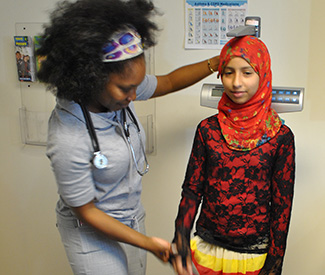
Roles
 Together with the SBHC staf, determine who will handle oversight for the various elements of the program, including preparation before, coordination during, and any processing after the event. Consider whether extra staff may be requested to help facilitate the event.
Together with the SBHC staf, determine who will handle oversight for the various elements of the program, including preparation before, coordination during, and any processing after the event. Consider whether extra staff may be requested to help facilitate the event.
If the budget is limited and budgeting for additional staff is not possible, consider how health profession trainees might be used for support in exchange for service learning experiences. Using supervised volunteer personnel, such as health profession trainees, can also increase billing potential by increasing the number of patients seen in one period of time, without decreasing the quality or content of the visit, in addition to cutting down personnel costs.
Defining & Assigning Responsibilities
Use staff meetings or other regular interactions with staff to elicit feedback on program development and to provide role information.
Be sure all staff clearly understand their role and responsibilities. Consider using one of these meetings to do a “dress rehearsal” to review how the students will flow through the event. If outside staff or volunteers will be used to support your program, consider what type of orientation they might need to become familiar with your site or program.
Be prepared to adjust your flow for unexpected events during your program.
Communication
As your event approaches, take opportunities to regularly check-in with the school administration and teachers involved in the event, to share your outline of the event flow and confirm timing, etc.
If you are using health professions trainees to support your event, develop a brief outline or handout that university faculty can use to prepare trainees for the event.
If possible, make time for a staff debrief at the end of at least the first program day, to review successes and challenges and make any necessary changes to improve future events.
This information is adapted from the Population-Wide Screenings in Schools Guide: A publication of UCSF and Family Health Together. We are grateful to our partners at ETR for funding and the UCSF School of Nursing for creating this content: Naomi Schapiro, RN, PhD, CPNP; Emily Green, RN, PhD; Victoria F. Keeton, PhD, RN, CPNP-PC; and Ivette Gutierrez, M.A.
We would also like to acknowledge Alameda County Center for Healthy Schools and Communities, Oakland Unified School District, La Clínica de la Raza, Native American Health Center, Lifelong Medical, Karen Gersten-Rothenberg, and Joanna Bauer for their contributions to this toolkit.
Photo credit: Randall Ann Homan



